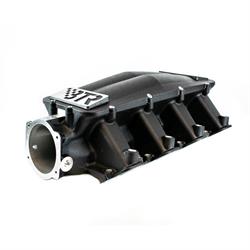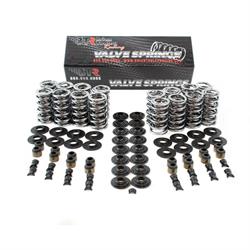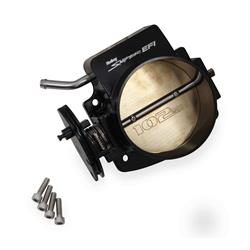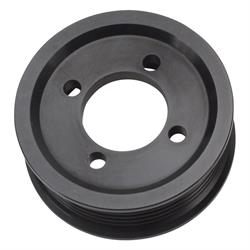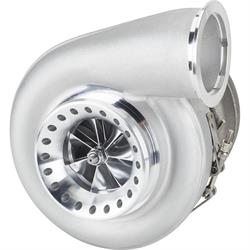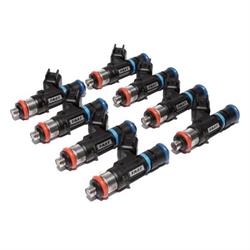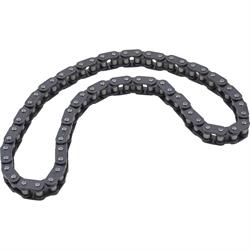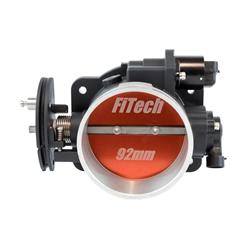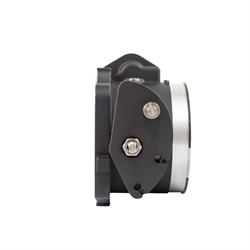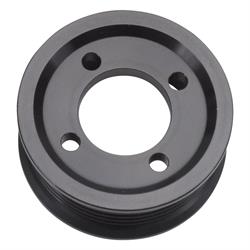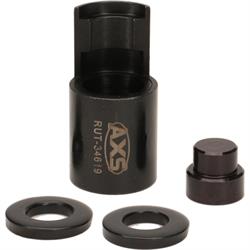6.0 LS Build Combinations: Recipes for 500-1,000 HP
What is the Best 6.0 LS Engine?
A stock 6.0L LS is factory rated around 300 hp and 360 lb-ft of torque, give or take, depending upon the application and model year of the donor vehicle. That’s a great starting point in anyone’s book, but like most enthusiasts, we want more. The good news is that when it comes to a budget 6.0 LS build, you can make some great power without spending thousands of dollars to do it. The popular LS 6.0 junkyard build has been well documented all over the Internet and YouTube, so we’re going to focus on the best starting point for your build and then break down popular horsepower thresholds from mild to wild and what it takes to reach them.
So where do you start with your 6.0 LS performance build? Finding a cheap 6.0 LS build candidate is often as easy as hitting your favorite salvage yard. There are tens of thousands of GM vehicles ripe for picking. Start your budget 6.0 LS build off with one of these salvage yard finds and you’ll already be saving money you can put toward performance parts to hit that magic horsepower number you’re after. But what is the best 6.0 LS for your intended project? Hands down the most popular LS 6.0 junkyard build fodder is going to be an LQ9 build. What’s an LQ9? It is an iron block Gen 3 6.0 LS used in the 2002-2007 Chevy, GMC, and Cadillac trucks, vans, and SUVs (8th digit of the VIN will be a N), which means they are very plentiful and cheap! From a marketing standpoint GM called them the Vortec HO 6000 or Vortec MAX, and the plastic engine cover makes them easy to spot. Besides the strong iron block, which is great for boost, the factory flat top pistons provide a bit more compression, which in turn means a nice bump in horsepower and torque (345HP/380LBFT) when compared to other 6.0L LS engines. A budget LQ9 build makes for a fun LS project that’ll easily work in your muscle car or classic truck.
But what about other Gen 3 LS 6.0 junkyard build options? There is only one other option out there, which is the LQ4 iron block truck engine found in the 1999-2007 GM trucks, vans, and SUVs. Known as the Vortec 6000 (8th digit of the VIN will be a U), the LQ4 was the predecessor of the LQ9 and featured the same block and heads, but with dished pistons providing lower compression and 15 to 45 less horsepower than the LQ9 depending on model year. Not to say it isn’t a good starting point, as if you’re intending on going with a turbo or supercharger the dished piston configuration’s lower 9.4:1 compression would be beneficial in that type of build. So don’t count a budget LQ4 build out, you’ll be pleasantly surprised at what this version of the 6.0 LS can do.
Moving into the Gen 4 6.0 LS engines you have several good options here as well, though you will have to address GM’s Active Fuel Management and Variable Valve Timing updates these engines were given. Most of the Gen 4 6.0 LS engines are based on aluminum blocks but there are a couple of iron block truck applications to consider as well. You can delete the AFM with one of our AFM delete kits. While AFM is part of all Gen 4 LS engines, only a select few use VVT. Some people leave the VVT active up to a certain point, but if you’re going to do any valvetrain upgrades, especially a performance camshaft, you’re going to have to delete the VVT function by using a Gen 3 timing cover and associated parts. A VVT delete kit will also require PCM tuning, just a head’s up if you’re using stock EFI wiring/PCM in your LS swap.
GM’s Gen 4 LS engines are found in cars such as Camaro, Corvette, and Cadillac offerings starting in 2005, plus of course the large cross section of trucks and SUVs as well. One of the most sought after Gen IV LS 6.0 engines is the LS2. An LS2 build is quite popular due to the availability of these 6.0 LS engines. It’s aluminum block is strong, yet lighter than cast iron Gen III and IV offerings. You’ll find the LS2 both in cars (8th digit of the VIN will be a U) and trucks (8th digit of the VIN will be a H). The LY6 makes for a great 6.0 LS build starting point as well. These are iron block truck engines (8th digit of the VIN will be a K) labeled a Vortec 6000 and feature rectangular port heads versus the more familiar cathedral port, which can support higher horsepower due to their increased flow. An LY6 build is certainly a great option here as well.
Other rectangular port 6.0 engines you might score in the junkyard for your 6.0 LS build include the L76 aluminum block found in cars (8th digit of the VIN will be a Y) and trucks (8th digit of the VIN will be a Y, look for the “Vortec MAX” engine cover) as well as the L77 aluminum block car engine (8th digit of the VIN will be a 2) and the L96 iron block truck engine (8th digit of the VIN will be a G). Note that the L96 has VVT that needs to be dealt with. Any of these will work in a classic hot rod or muscle car using one of our LS swap oil pans for clearance.
The last two 6.0 LS build prospects on our list are GM’s 6.0 LS hybrids, the LFA (8th digit of the VIN will be a 5) and the LZ1 (8th digit of the VIN will be a J). These are both aluminum block truck engines with cathedral port heads labeled as “Vortec 6000” with a separate “Hybrid” cover over the hybrid control module under the hood. The LFA was used in trucks from 2008-2009, while the LZ1 was used from 2010-2013. Besides the popular Gen 4 6.0 LS under hood, you’ll find two electric motors built into the geartrain of the transmission along with a 300-volt battery under the rear seat.
While there have been a few that have entertained a complete 6.0 LS build using the complete hybrid system, we suggest only using the LFA or LZ1 if that is your only local option and you are planning to build it up with a different cam, custom accessory drive and more for your LS swap application needs. If you have any concerns about just what you’re looking at under the hood of that truck or SUV at the salvage yard, our LS engine identification guide will help with its VIN code list, engine specs, and more.
How Much HP Can a 6.0 LS Make?
If you’ve been researching a 6.0 LS builds for any length of time you’ve no doubt spent considerable time watching YouTube videos from Richard Holdener taking LS engines to the breaking point. From its 300 and change factory horsepower we’ve seen several stock bottom end (SBE) builds take upwards of 25 plus pounds of boost and survive in his videos. Stuff like that makes for great clicks/views and subscribers but will it survive on the street in a real installation you have in mind. That’s debatable. So, how much hp can a 6.0 LS handle? Holdener, arguably the most prolific LS engine builder/tester out there, has put both Gen 3 and Gen 4 high mileage junk yard SBE 6.0 LS engines on the pump with nothing more than increased ring gap, a boost friendly camshaft, aftermarket heads and intake and made north of 1,400 horsepower!
So, let’s just say that, yes, a 6.0 LS can make upwards of four digit horsepower if you really want to. Maybe the real question here should be how much HP can a 6.0 LS build make and live a long healthy life under the hood of your project? For that answer we’re going to be much more conservative and say anything much over 600 horsepower and you’re looking at major internal upgrades. In those same tests Holdener ran the Gen 3 and Gen 4 6.0 engines without boost (but with the heads, cam, and intake) and made just over 500 hp. Adding boost to that starts you down the path of better rods, pistons, and more. The Gen III powdered metal rods are really the weak point in any high boost 6.0 LS build, so you’re going to have to go inside the block for updates.
You must be honest with your budget, your project needs, and your expectations. Do we all want a 1,000 hp 6.0 LS build with twin turbos for bragging rights? Sure we do, but having a heads/cam/intake 6.0 LS build making 600 plus horsepower in your classic Camaro or Chevelle is still going to more than the factory big block ever put to the ground and your wallet will thank you for the savings (which can be used for brakes and tires to keep all that power under control!). A single turbo LQ4 build is actually pretty easy on the wallet though, just make sure you have the fuel system and other bits to support it. To summarize, a stock 6.0 will make about 300-340 HP. It’s possible to push 1,000 HP from a 6.0 LS, but a great budget build will easily get you 500-600 HP.
What Fuel System Is Needed to Support My Horsepower?
Below you will find “recipes” for popular horsepower levels for a performance 6.0 LS build. It is surprisingly easy to scratch that 400 horsepower itch with little more than a cam swap when it comes to the budget 6.0 LS build, just note that at that power level you’re close to maxing out the stock injectors and fuel delivery system. In most cases we’re talking about a classic vehicle 6.0 LS swap, so the fuel delivery system will be a new purchase anyway (we offer a great line of application specific EFI fuel tanks for builds like these that include an in-tank fuel pump. Just add a regulator, and fuel lines to complete your LS swap fuel system. For those making big steam a move to running E85 will be necessary using compatible E85 fuel pump, line, and injectors.
The injectors though are a different story. Changing injectors to support more horsepower gets a little tricky due to the different injectors the 6.0 LS came with over the years. Depending upon OE application there are three different injector wiring connector styles and several injector heights. When shopping for EFI fuel injectors you’ll have to keep this in mind, as your original wiring, or aftermarket EFI wiring may require a specific injector connector type. You can find injector connector adapters available online or carefully swap out the connectors and terminals on your harness, but your best bet is to know what injector your harness uses and buy the proper injector from the start. For example, our Vortec LS engine swap harnesses use Multec 2 style injector connectors.
As for the height differences, sometimes this can be made up using fuel rail or injector spacers that can be used to make up the difference for short or long injector bodies. This is usually only a problem when using stock truck injectors on a car intake, or vice versa, but just know that injectors are often a stumbling block when putting together a higher horsepower 6.0 LS build. We recommend new aftermarket injectors versus trying to cobble together used injectors that may have different flow rates, as GM is famous for making small injector changes during production. A 1999 truck 6.0 injector may be different than a 2007 6.0 truck injector.
500 HP 6.0 LS Build Parts List
500HP 6.0 LS Build Parts List (view price and availability)
Notes:
If you have the budget, we highly recommend adding these additional items to your build list:
- PRW Trunnion Upgrade Kit
- LS7 Roller Lifters (order two quantity)
- LS7 Lifter trays (order four quantity)
- GM Replacement Timing Chain
- Holley Sniper 92mm Throttle Body
The Trailblazer SS intake does not include fuel rails. You will either need to source the OEM fuel rail or use aftermarket rails like Holley’s LS truck intake fuel rail kit.
If you do not have a throttle body to transfer IAC and TPS sensors you can substitute the FiTech 92mm throttle body for the Holley one listed, as it comes complete.
550 HP 6.0 LS Build Parts List
550HP 6.0 LS Build Parts List (view price and availability)
Notes:
If you have the budget, we highly recommend adding these additional items to your build list:
- PRW Trunnion Upgrade Kit
- LS7 Roller Lifters (order two quantity)
- LS7 Lifter trays (order four quantity)
- GM Replacement Timing Chain
- Holley Sniper 92mm Throttle Body
The Trailblazer SS intake does not include fuel rails. You will either need to source the OEM fuel rail or use aftermarket rails like Holley’s LS truck intake fuel rail kit.
If you do not have a throttle body to transfer IAC and TPS sensors you can substitute the FiTech 92mm throttle body for the Holley one listed, as it comes complete.
600 HP 6.0 LS Build Parts List
600HP 6.0 LS Build Parts List (view price and availability)
Notes:
If you have the budget, we highly recommend adding these additional items to your build list:
- Comp Cams BSR Shaft Mount Rocker System
- Comp Cams Hi-Tech Pushrods
- LS7 Roller Lifters (order two quantity)
- LS7 Lifter trays (order four quantity)
- GM Replacement Timing Chain
If you do not have a throttle body to transfer IAC and TPS sensors you can substitute the FiTech 102mm throttle body for the Holley one listed, as it comes complete.
700 HP 6.0 LS Build Parts List
700HP 6.0 LS Build Parts List (view price and availability)
Notes:
If you have the budget, we highly recommend adding these additional items to your build list:
800 HP 6.0 LS Build Parts List
- VS Racing VSR-400 80mm Turbo
- Hooker Single Turbo Exhaust Manifold Kit
- Edelbrock Victor CNC 11-Degree Heads (order two quantity)
- BTR Equalizer Intake Manifold
- Comp Cams LST Series Stage 2 Cam
- BTR Dual Valve Spring Kit
- VS Racing 50mm Turbo Wastegate
- FAST 85 lb/hr Fuel Injectors/Set of 8
- Holley Sniper 102mm Throttle Body
- Speedmaster 1997-2003 Head Stud Kit
- LS Engine Gasket Set
- GM Balancer Bolt
800HP 6.0 LS Build Parts List (view price and availability)
Notes:
If you have the budget, we highly recommend adding these additional items to your build list:
- LS7 Roller Lifters (order two quantity)
- LS7 Lifter trays (order four quantity)
- PRW Trunnion Upgrade Kit
- GM Replacement Timing Chain
At this power level E85 fuel is required, especially if retaining the stock bottom end (SBE) of your 6.0L LS.
The Hooker cast iron turbo manifolds work with Hooker’s line of transmission specific exhaust crossover tubes to create a bolt on turbo exhaust.
For a more efficient inlet charge (and more horsepower) adding an intercooler is a great option if you have the room to mount it.
If you do not have a throttle body to transfer IAC and TPS sensors you can substitute the FiTech 102mm throttle body for the Holley one listed, as it comes complete.
1,000 HP 6.0 LS Build Parts List
- VS Racing VSR-400 80mm Turbo
- VS Racing Forward Facing Turbo Header Kit
- Edelbrock Victor CNC 11-Degree Heads (order two quantity)
- BTR Equalizer Intake Manifold
- Comp Cams LST Series Stage 2 Cam
- BTR Dual Valve Spring Kit
- VS Racing 44mm Turbo Wastegate (order two quantity)
- FAST 85 lb/hr Fuel Injectors/Set of 8
- Holley Sniper 102mm Throttle Body
- Speedmaster 1997-2003 Head Stud Kit
- LS Engine Gasket Set
- GM Balancer Bolt
1,000HP 6.0 LS Build Parts List (view price and availability)
Notes:
If you have the budget, we highly recommend adding these additional items to your build list:
- Mahle PowerPak Piston Kit
- BTR H-Beam Connecting Rods
- LS7 Roller Lifters (order two quantity)
- LS7 Lifter trays (order four quantity)
- PRW Trunnion Upgrade Kit
- GM Replacement Timing Chain
At this power level E85 fuel is required, especially if retaining the stock bottom end (SBE) of your 6.0L LS.
If upgrading rods and/or pistons realize you will also need bearings and/or piston rings to complete their installation once your machine shop spec’s the dimensions.
Inspect the factory crankshaft; it can be reused at this power level if in good condition. Be sure to weld the 24x reluctor solid to the crank if running a Gen 3 style reluctor wheel.
For a more efficient inlet charge (and more horsepower) adding an intercooler is a great option if you have the room to mount it.
Helpful Tools for Your 6.0 LS Build
The LS engine family is an easy engine to work on, but there are a few special tools that always make things go more smoothly out in the garage, be it mocking up an LS swap, or just handling a cam swap in the car. These are some of our picks that will help get the job done and keep things moving forward.









